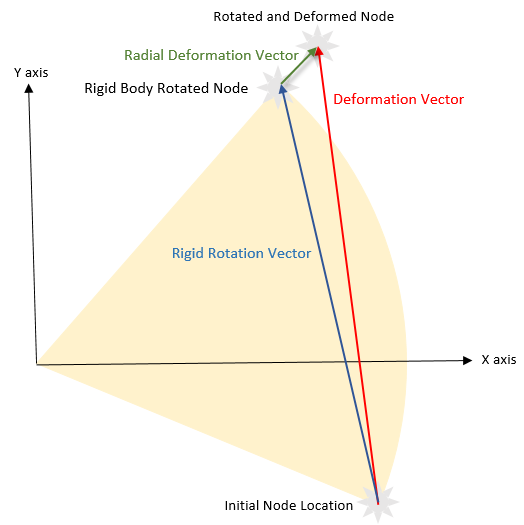-
-
February 5, 2024 at 12:46 am
afshintaghvaeipour
SubscriberI have a hemisphere shell which is vibrating and simultaneously rotating. I need to read the radial displacement of a node. To do this I define a cylindrical Cs attached to the shell. Now when I ask for the x component of displacement it does not report correct value. It seems it adds the displacement due to rotation to the deformation as well.
Thanks
-
February 5, 2024 at 2:11 am
peteroznewman
SubscriberCoordinate frames are attached to ground, they are not attached to nodes or elements and do not rotate with a moving node.
Nodal displacements report the change in coordinates from the initial location to the current location relative to ground. That change can be measured in Rectangular or Cylindrical coordinates.
-
February 5, 2024 at 2:59 am
afshintaghvaeipour
SubscriberThanks Peter
Do you have any suggestion on this matter?
-
-
February 5, 2024 at 3:04 am
afshintaghvaeipour
SubscriberThanks Peter,
Do you have any suggestion on this matter? Also, how about applied forces? Do they rotate by the body to which they are scoped in a cylindrical Cs?
-
February 5, 2024 at 2:04 pm
peteroznewman
SubscriberBy default, applied forces do not change direction when the node rotates around an axis. In a nonlinear analysis with Large Deflection On and the nodes in a rectangular coordinate system, if the force is in the X direction, and the node rotates by 90 degrees, the force will still be in the X direction. I’m not sure what happens in a cylindrical system. Though the X direction is radial, I think the radial direction is determined from the initial location of the node and does not rotate with the node. Maybe your model is demonstrating that behavior.
It is possible to enable a Follower Force that does rotate with the node. Here is a discussion that explains how to do that. /forum/forums/topic/how-we-can-apply-a-follower-load-or-nonconservative-force-in-ansys/ Another discussion points to the Ansys Help Page. /forum/forums/topic/non-conservative-follower-force/ To open the URL in that discussion, first start Ansys Help, then copy that URL from that discussion and paste it into the address bar of the browser running Ansys Help.
Note that Pressure loads, by default, always follow the rotations of the element faces that they are applied to. The pressure is always normal to the element face. No code is needed for the pressure to follow the rotation of the element.
-
February 5, 2024 at 3:34 pm
afshintaghvaeipour
SubscriberThanks Peter, that helps a lot. And how about displacement? Then literally it is not possible to read a rotating radial displacement?
-
February 5, 2024 at 5:34 pm
peteroznewman
SubscriberAlmost anything is possible, it is only a question of how much code (if any) is needed to accomplish the result you want.
You know the initial coordinates of the node and you know the rigid body rotation of the node at any time t during the simulation, so calculate the rigid rotation vector RR of the node at that time. Request three directional deformations, one for each axis that tell you the deformation of the node at time t to form the deformation vector D. Use vector math to get the “radial” deformation vector RD = D – RR. Note that the “radial” deformation may include axial and tangential deformations as well as deformations in the radial direction. A dot product of the unit radial vector at time t and the vector RD will give you the magnitude of the radial component of the RD vector.
-
February 6, 2024 at 3:46 pm
afshintaghvaeipour
SubscriberThank you very much Peter. It is a very good idea. It works.
Regards
-
- The topic ‘Radial displacement’ is closed to new replies.



-
4607
-
1510
-
1386
-
1209
-
1021

© 2025 Copyright ANSYS, Inc. All rights reserved.








